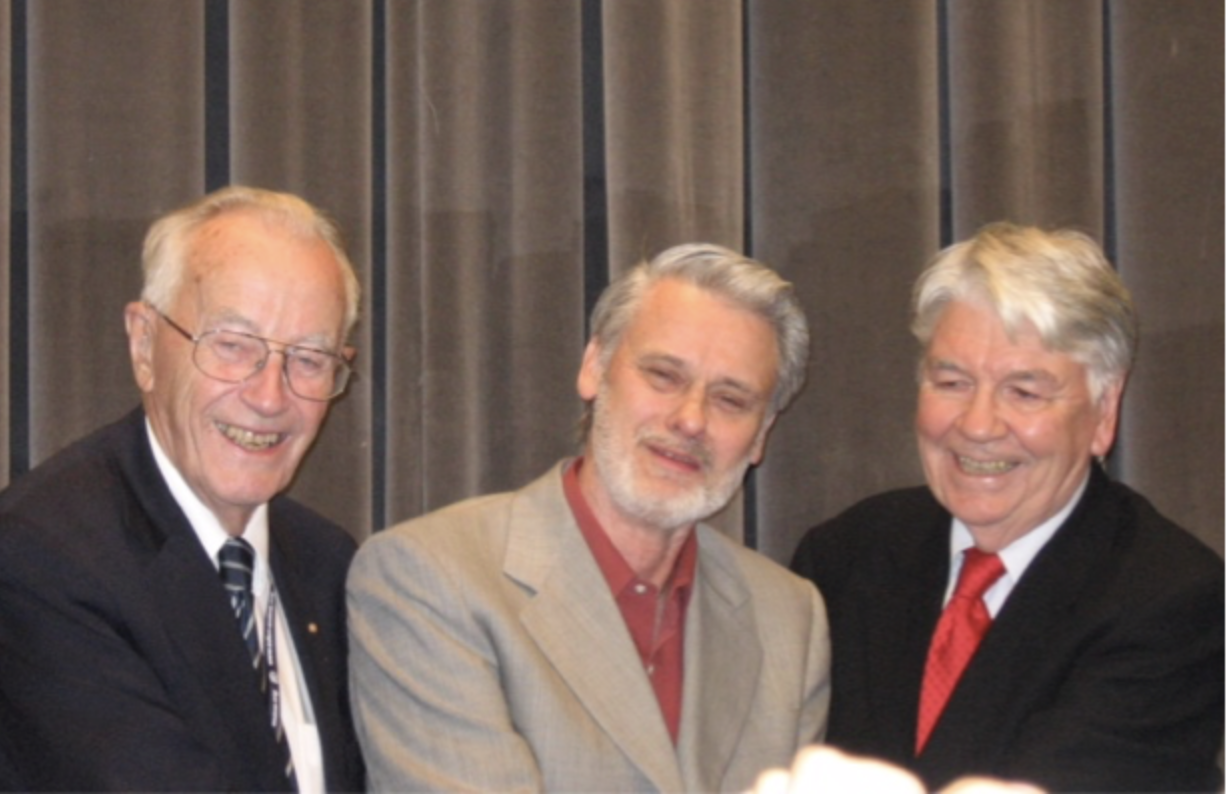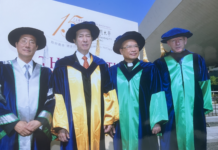
Zawacki-Richter, O. and Jung, I. (2023) The Handbook of Open, Distance and Digital Education Singapore: Springer
Reviews
Normally, I would start by introducing you to the contents, in this case the chapters in Section 1 of the book. However, by the time you have read your way through even the briefest descriptions of the 14 different contributions (236 pages in all) in just the first section of this book, I will have lost you as a reader, so I will start with my review of the first section of this book, on history, theory and research in ODDE. Then you can go and look at my synopsis of specific chapters that may interest you.
General review comments
This book is far too long, partly because there is too much good stuff in it. It’s like mining minerals in Northern Canada: there’s lots there, but finding and extracting it is a nightmare. The editors deserve some blame here. There is a fair amount of duplication, and many chapters should have been rejected, not because they were not well written or relevant, but to provide more focus on key issues. Little consideration seems to have been given by the main editors to who the potential readers might be, and how best they could be served. I suspect that the main target group are the contributors themselves – another publication under their belt.
It may seem churlish to complain about any book that is freely and openly accessible, but delivering an open textbook of this length in pdf is horrible. 1,400 pages in pdf format – and not a single illustration. Navigation between chapters is clumsy, and the text jumps as you try to navigate from one page to the next. Open textbooks need their own technology, such as WordPress, not an almost pre-digital technology like pdf.
I fear that when I have finished reviewing all 1,400 pages, you will need to put me in a straight-jacket and cart me off to the nearest asylum. It need not be like this. It could have been produced in several volumes over time, in a more accessible format. However, enough whingeing – now to the good stuff.
History
There are three chapters specifically on the history of ODDE. I have lived through most of the history, so there wasn’t anything really new in these chapters for me. But history is important. A recurrent problem in ODDE is a failure to learn from the past. The more prestigious the newcomer (such as MIT with MOOCs) the more likely they are to fail to learn that a round wheel works better than a square one.
But the three chapters do deliver. They provide a comprehensive and authoritative account of the history of at least distance education and technology, less so regarding open education. The chapter on open education was really more theory than history – see below for a more detailed critique of the article.
Whether though newcomers will bother to learn the history is another matter – but at least you have somewhere to send them.
Theory
Again, good coverage across most of the traditional and emerging theories. The treatment though of artificial intelligence in the book was inadequate. AI is going to be a huge issue for ODDE going forward and deserves much better treatment. Stephen Downes argues the need for more modern theories to support digital learning, with which I agree (but not necessarily with his theory).
The problem I have with the theories of ODDE is that they have had little effect on the practice of ODDE. Most ODDE was developed without any influence from the classical distance education theorists. Indeed their theories are based on an analysis of prior practice.
Good theory though should provide guidelines for the future. Most practice in ODDE is not driven by theories of distance education but by general theories of learning and new advances in technology. Indeed the book lacks any reference to the work of Harasim or Salmon on collaborative online learning, for instance, which does have a theoretical background, and is highly relevant to digital learning.
Indeed, I question whether it makes any sense to expect a theory of distance education, which is primarily a method of delivering education. Would you expect a theory of schools or university campuses – or buses?
Research
There are just two chapters on research in this section, both excellent. Indeed, I would like to have seen more on research methodologies and issues in researching ODDE.
So in this section I make it three chapters on history, five on theory and two on research, plus a book introduction and a section introduction. I think there is too much on theory and not enough on research, but others may feel differently. But as a result, this part of the book, with one or two exceptions, is for me too backward looking and not focused enough on contemporary issues (such as the impact of AI, and ethical issues in the use of big data). I also think that this emphasis on history and theory is a weak attempt at legitimizing the field of ODDE. Get over it. It’s here to stay. Look to the future, not the past.
Now for a brief synopsis of the chapters in this section.
1. Book Introduction
Zawacki-Richter and Jung provide ‘a brief overview of the overall structure‘ of the book and state that the book ‘aims to provide a comprehensive and solid overview of the field for educators, researchers, policymakers, and administrators in such sectors as k-12 education, higher education, adult education, and workplace training.‘
There is a brief discussion of ODDE terminology. ‘We conceptualize ODDE as an overarching term to refer to all kinds of learning and teaching processes in which knowledge and skill base of educational technology, digital media, and tools are used to present and deliver content, as well as facilitate and support communication, interaction, collaboration, assessment, and evaluation.‘
The editors then explain the organization and structure of the book. Each section is divided into three ‘levels’:
- macro-level (national, regional and global systems)
- meso-level (educational institutions)
- micro-level (individual learners and teachers)
with two chapters at each level. Each section has a sub-editor who introduces the section and provides a conclusion.
2. Chapter by Chapter Review
2. Introduction to Section 1
The editor of this section is Junhong Xiao, of the Shantou Radio & Television University/The Open University of Shantou, Shantou, China. In his introduction, he complains that even after more than sixty years of ODDE, ‘conventional higher education institutions, especially elite universities, tend to be more favorably perceived simply as a result of their high reputation as an academic institution, while ODDE offered by dedicated ODDE institutions continues to be questioned one way or another’. To get fair treatment, he argues that ODDE needs to be ‘historically rooted, theoretically underpinned, and research-informed…..This section aims to expound on the relevance of history, the necessity of theory, and the imperative of research to ODDE researchers and practitioners’.
3. From correspondence education to online distance education
This chapter, by Michael G. Moore, The Pennsylvania State University, USA, is, as expected, a comprehensive and thoughtful brief history of at least distance learning. He covers developments in many different countries and links them through the development from correspondence to open universities to virtual learning. There was quite a bit in his chapter that was new to me, even though I like to think I know the history pretty well.
His lessons from history are particularly interesting, especially: ‘only modest gains can be achieved by adopting new technology without changing teaching itself, from a single-person craft to a team process within a delivery system, and this requires broad and deep reform of educational institutions, especially their budgets and human resource management. Consequently, the most important historical research in the near future will be the study of institutional change, and the reform of national educational systems.’
4. Open education as a social movement
This chapter, by Marco Kalz, of Heidelberg University of Education, Germany, analyzes open education initiatives through the lens of social movement theory.
He raises some excellent points about the limitations of current approaches to open education. He does not consider it meets the definition of an effective ‘social movement’:
- ‘a clearer picture of the stakeholders of open education would need to be developed and those stakeholders would need to be explicitly included in the discourse to move open education towards a social movement. This would imply that the disadvantaged learners and learners without access to educational opportunities would be enabled to contribute to the discourse on open education…
- In times of scarcity of funding, investment into OER development programs should have as a basis an expected educational effectiveness instead of a value-based belief in openness….
- the field as a whole resembles an epistemic community more than a social movement.’
I agree with Kalz that a lot of discussion around ‘open’ at the moment is too narrow and focused merely on access to resources. OER and MOOCs are not making much impact on ‘open-ness.’ However, Kalz ignores the issue of increased functionality and cost-effectiveness of digital learning that the use of open educational resources can bring. But then that is outside the scope of social movement theory.
More importantly, this article makes the classic mistake of ignoring history and geography. Open access to education has been and is a social movement. The establishment of open universities around the world in the 1970s met all the criteria of a social movement. For instance in Britain, less than 17% of those leaving school went on to university until the Open University was established. However, in economically advanced countries this battle has now largely been won. In most G20 countries, those who want a post-secondary education can get one, and access to schools is universal.
This is not the case though still for two-thirds of the world’s population. Many still do not have access even to high school education and even less to post-secondary education. If the demonstrations of brave Afghan women demanding access to school and university is not a social movement, what is?

This book needs a chapter that reflects this wider approach to open education, and the role of ODDE in meeting this goal.
5. History and Development of Instructional Design and Technology
This article, by Michael Molenda of Indiana University, USA, overlaps to some extent with Michael Moore’s. Molenda’s is focused on both technology developments and the parallel rise of instructional design.
One of the dangers of writing an historical account of educational technology development is that it becomes a chronological list categorised by types of technology. Molenda however does have some useful insights arising from the historical development of technologies, such as the link between pedagogical approaches and technology innovation, and the related rise of instructional design as a profession. Molenda does a good job of describing the historical origins of instructional design and the influence of different pedagogical approaches on ID.
Molenda makes the important point that educational technologies tend to be promoted mainly by those who are not educators but professionals in the technology, for instance radio or television producers or computer scientists. As new technologies emerge, there is no shared concept of history or past lessons learned as these new technologies are promoted in education.
6. The Rise and Development of Digital Education
I have already reviewed this chapter by Martin Weller, of the UK Open University, in my ‘first impression’ review.
7. Artificial intelligence in Education and Ethics
I have already reviewed this chapter by Benedict du Boulay, of the University of Sussex, UK, in my ‘first impression’ review.
8. Classic Theories of Distance Education

This chapter, by Terry Evans and Victor Jakupec of Deakin University, Australia, explores the influence of three of distance education’s classic theorists—Otto Peters, Börje Holmberg, and Michael Moore—on its subsequent conceptualization and practice. The authors also discusses Keegan’s theory of teaching-learning integration, Garrison’s Communication and Learner Control Theory, and Verduin and Clark’s Theory of Dialogue.
The authors provide a clear account of these different ‘classical’ theories. They conclude that ‘the social imperatives for distance education persist into the 21st century, and distance education continues to reposition and repurpose itself by adopting and adapting new technologies to its purposes.’
However, this chapter does not include any theories associated with the move to digital learning.
9. Newer theories for digital learning spaces
This chapter, by Stephen Downes, of the National Research Council, Canada traces the sources for a dissatisfaction in traditional theories such as behaviourism and cognitivism, and some theoretical attempts to address them. It identifies a range of emerging theories, including connectivist pedagogy, personal learning environments, and educational practices. Downes ends by arguing for a reconceptualisation of theory.
Downes provides a concise and helpful discussion of theory in education and concludes:
It became apparent that knowledge and learning are based on much more than mere transmission of information, as the nature of the learner and the learner’s environment play key roles, and context and community assume a much greater importance. Because these must be explicitly created in a digital learning environment, rather than inherent in, say, a classroom or workplace, their nature and development assumed a greater importance in learning theory and design.
He then goes on to discuss newer theories for digital learning, such as connectivism. I will not try to explain connectivism – read the article – but it is based on the concept of dynamic networks, and especially self-organised structures. (For my critique of connectivism, see A review of Stephen Downes’ latest contribution to the theory of connectivism.) Downes makes a strong case for the need for new theories to advance our understanding of digital learning.
10. Pedagogical paradigms in Open and Distance Education
This chapter, by Jon Dron and Terry Anderson, of Athabasca University, Canada is concerned with analyzing the three broad pedagogical paradigms – objectivist, subjectivist, and complexivist – that have characterized learning and teaching in the field over the past half century and goes on to discuss new paradigms that are starting to emerge, most notably in “theory-free” models enabled by developments in artificial intelligence and analytics:
‘By examining how pedagogical approaches have developed in a complex dance with tools and systems that enable them, we seek to highlight how distance learning pedagogies owe their origins to in-person learning, how this has impacted their development, and how the pedagogical pathways of open and distance learning have increasingly diverged from their in-person ancestors.’
They make the following significant point: ‘For learning in a classroom, you could often take away almost anything apart from a teacher and students, including the classroom itself, and it would still be recognizably the same thing. Without the media and tools that enable distance teaching, it would not occur at all.‘
Their discussion of complexivist theories is an extension and broadening of Downes’ connectivism. Their main point is that ODDE has adopted many pedagogies that were necessary to meet the limitations of in-person teaching, but ODDE requires different pedagogies to meet the limitations – and potential – of distance education and digital learning.
11. Theories of motivation and empowerment in open, distance and digital education
This article, by Catherine Ng, of the Australian Catholic University, deals with a topic that face-to-face instructors often ask when moving online: ‘But how do I motivate online learners?’ (as if motivating students on campus is not a problem.)
Ng looks at three types of motivational theory: socio-cognitive, socio-cultural and Perezhivanie.
Within socio-cognitive motivation, Ng describes four factors that influence motivation:
- self-efficacy
- achievement goals
- intrinsic motivation
- self-regulation
She concludes: more research effort is certainly required to examine how verified motivational enablers can be used to inform instructional designs to promote distance learners’ motivation and engagement
She then looks at socio-cultural approaches to motivation, and in particular the social origin of motivation and how it operates beyond an individualistic orientation. This is important, she argues, because advanced Internet and computing technologies have enabled asynchronous and synchronous interaction, highlighting ODL as an interactive learning process. This technological turn situates ODL in a technology-enabled social context and challenges the characterization of distance learners as lone learners working through guided materials in a solitary manner.
Finally, she explores the importance of Vygotsky’s theory of Perezhivanie, understood generally as an emotional lived experience, for understanding motivation.
Although Ng does not take the next step of suggesting design strategies that will increase or improve motivation in ODDE learners, a deeper understanding of the different ways motivation works could be helpful to most online instructors.
12. Technology acceptance and adoption in education
This article by Adrina Granic, of the University of Split, Croatia, provides a description and analysis of the main research findings in the area of educational technology acceptance, adoption, and usage.
For me, this was like discovering a whole new world that I knew nothing about. There are actual theories that predict the adoption and acceptance of an educational technology! Who would have thought?
It appears that the most adopted theory is TAM, the Theory of Reasoned Action. This assumes that humans are basically rationale (a questionable assumption for me), so the key factors leading to adoption and acceptance are the perceived usefulness of a technology, and its perceived ease of use. To which my response was: duh! Apples fall from trees. There are other theories, such as UTAUT, that add other factors, depending on the technology. It would be nice though if educational effectiveness was a reason for adoption, but that would be to expect too much.
It’s nice to know that there are people who spend time on this sort of thing.
13. Research trends in open, distance and digital education
This article, by Olaf Zawacki-Richter of Oldenburg University, Germany, and Aras Bozkurt, of Anadolu University, Turkey, is a meta-analysis of research on ODDE published in selected academic journals, organised by the 3M principle of macro, meso and micro level research.
They divide research into ODDE into 15 different research areas (similar to the organisation of this book).The analysis was based on 10,827 articles published between 2007 and 2016 in 26 educational technology, instructional design, and distance education journals, with a bias towards English language journals. The journals are clustered into four categories:
- educational technology, learning and computer science
- educational technology from k-12 to higher education
- distance education in the context of higher education
- technology-enhanced learning in school settings.
The authors do a number of interesting analyses of trends in publication in this area. For instance, they comment: Over 50% of all articles deal with the top three issues, interaction and communication in learning communities (17.6%), instructional design (17.4%),and learner characteristics (16.3%), whereas other important areas (e.g., costs and benefits, innovation and change management, or intercultural aspects of distance learning) are dreadfully neglected.
They also identify four ‘waves’ over time of publications triggered by developments in the field:
- the consolidation of distance teaching institutions and instructional design;
- quality assurance and student support;
- virtual universities, online interaction,
- artificial intelligence, big data, and intelligent support systems
The chapter also discusses the impact of Covid-19 on research into ODDE.
This is a useful source for anyone contemplating publishing a research article in this area.
14. Big science and Little science in Open and Distance Education
This article, by Heather Kanuka, of the University of Alberta, Canada, is an excellent discussion of the pros and cons of using big science/data and little science/data. It provides useful definitions of big data and little data and suggests how they can be used together to balance their relative strengths and weaknesses. This chapter will be useful for anyone considering undertaking research into ODDE.
Conclusion
Well, I made it. Was it worth the effort? On balance, yes, but it was a lot harder than it needed to have been. I do hope you will read the actual articles if they appear of interest to you. Most are well written, soundly based, and often interesting.
Now for the next section, on Global Perspectives and Internationalization. But give me a week or so!









 Dr. Tony Bates is the author of eleven books in the field of online learning and distance education. He has provided consulting services specializing in training in the planning and management of online learning and distance education, working with over 40 organizations in 25 countries. Tony is a Research Associate with Contact North | Contact Nord, Ontario’s Distance Education & Training Network.
Dr. Tony Bates is the author of eleven books in the field of online learning and distance education. He has provided consulting services specializing in training in the planning and management of online learning and distance education, working with over 40 organizations in 25 countries. Tony is a Research Associate with Contact North | Contact Nord, Ontario’s Distance Education & Training Network.

